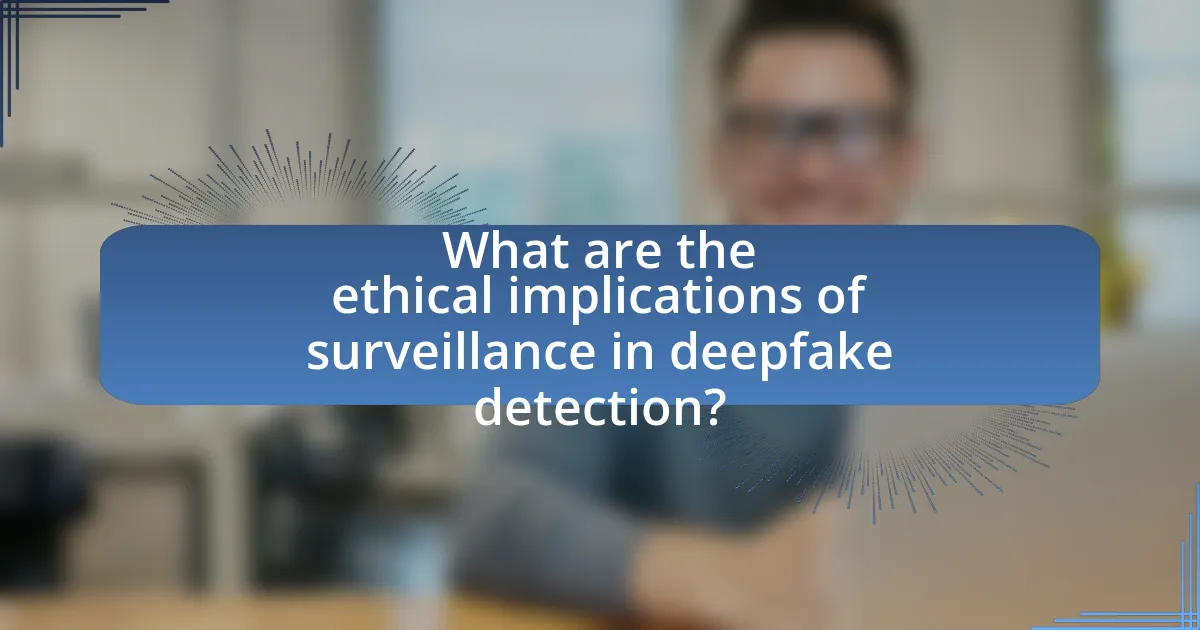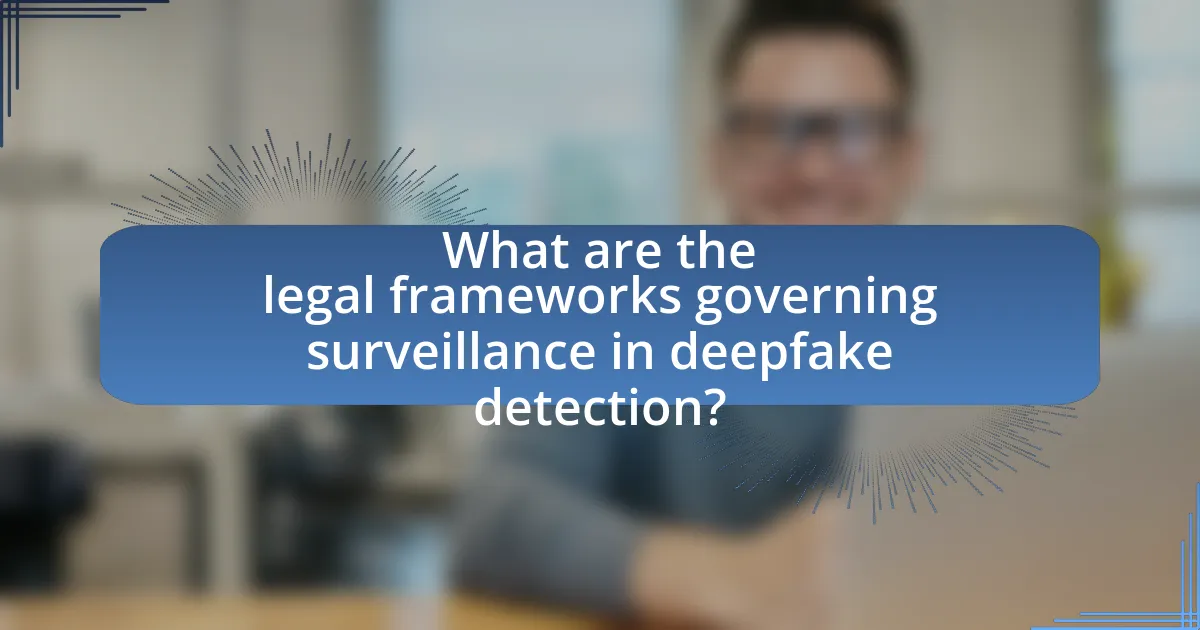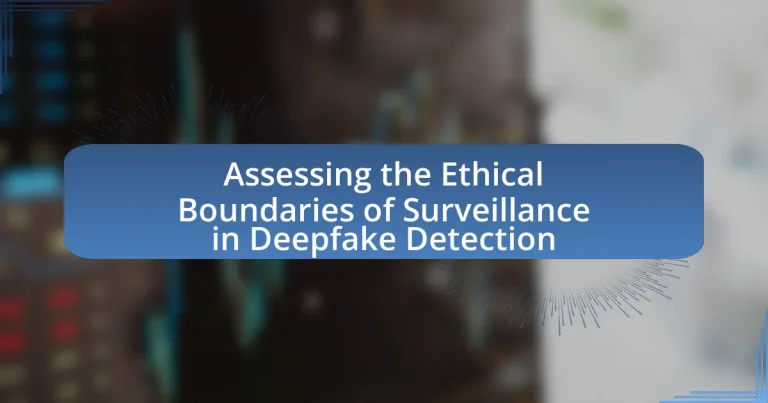The article focuses on the ethical boundaries of surveillance in deepfake detection, highlighting the intersection of privacy rights and technological advancements. It examines the implications of surveillance methods, such as facial recognition, in identifying manipulated media while addressing concerns about consent, data misuse, and potential harm to individuals. The discussion includes an analysis of legal frameworks governing surveillance practices, the importance of ethical assessments, and best practices for organizations to ensure responsible use of surveillance technologies. Additionally, it emphasizes the need for public awareness and education to foster accountability and ethical standards in the context of deepfake detection.

What are the ethical implications of surveillance in deepfake detection?
The ethical implications of surveillance in deepfake detection primarily revolve around privacy concerns and the potential for misuse of data. Surveillance technologies used to identify deepfakes can infringe on individual privacy rights, as they often require monitoring personal data without consent. For instance, the deployment of facial recognition systems to analyze video content raises significant ethical questions about consent and the extent to which individuals are aware of being surveilled. Additionally, the risk of false positives in deepfake detection can lead to wrongful accusations and reputational harm, further complicating the ethical landscape. These concerns highlight the need for clear regulations and ethical guidelines to balance the benefits of deepfake detection with the protection of individual rights.
How does surveillance intersect with deepfake technology?
Surveillance intersects with deepfake technology by enabling the monitoring and detection of manipulated media, which can be used for malicious purposes. Surveillance systems, such as facial recognition and video analysis, can identify discrepancies in video content, helping to flag potential deepfakes. For instance, a study by the University of California, Berkeley, found that advanced surveillance techniques can enhance the accuracy of deepfake detection by analyzing inconsistencies in facial movements and audio synchronization. This intersection raises ethical concerns regarding privacy and consent, as the use of surveillance for deepfake detection may infringe on individual rights while attempting to combat misinformation.
What role does surveillance play in identifying deepfakes?
Surveillance plays a crucial role in identifying deepfakes by enabling the monitoring and analysis of digital content for authenticity. Through advanced algorithms and machine learning techniques, surveillance systems can detect inconsistencies in video and audio data that may indicate manipulation. For instance, research has shown that surveillance technologies can analyze pixel-level changes and audio discrepancies, which are often present in deepfakes, thus facilitating their identification. This capability is essential in combating misinformation and protecting public trust, as evidenced by studies demonstrating that automated detection systems can achieve accuracy rates exceeding 90% in identifying manipulated media.
How can surveillance methods be misused in deepfake detection?
Surveillance methods can be misused in deepfake detection by infringing on privacy rights and enabling unauthorized data collection. For instance, the deployment of facial recognition technology in surveillance can lead to the identification and tracking of individuals without their consent, raising ethical concerns about personal privacy. Additionally, the use of surveillance data to falsely accuse individuals of being involved in deepfake creation can result in reputational harm and legal consequences. Reports indicate that misuse of surveillance technologies has led to wrongful arrests and discrimination, highlighting the potential for abuse in the context of deepfake detection.
Why is it important to assess ethical boundaries in surveillance?
Assessing ethical boundaries in surveillance is crucial to ensure the protection of individual privacy rights and prevent misuse of data. Surveillance technologies can infringe on personal freedoms and lead to potential abuses, such as discrimination or unwarranted monitoring. For instance, studies have shown that unchecked surveillance can disproportionately target marginalized communities, raising significant ethical concerns. By evaluating these boundaries, organizations can establish guidelines that promote responsible use of surveillance while balancing security needs with civil liberties.
What are the potential risks of unethical surveillance practices?
Unethical surveillance practices pose significant risks, including violations of privacy, erosion of trust, and potential misuse of data. These practices can lead to unauthorized access to personal information, resulting in identity theft or harassment. Furthermore, when individuals are aware of being surveilled unethically, it can create a chilling effect on free speech and expression, as people may self-censor to avoid scrutiny. Studies have shown that excessive surveillance can disproportionately target marginalized communities, exacerbating social inequalities. For instance, a report by the American Civil Liberties Union highlights how surveillance technologies often lead to racial profiling and discrimination. Overall, the implications of unethical surveillance extend beyond individual harm, threatening societal norms and democratic values.
How can ethical assessments improve deepfake detection strategies?
Ethical assessments can enhance deepfake detection strategies by ensuring that the technologies developed prioritize user privacy and consent. By evaluating the ethical implications of deepfake detection methods, developers can create systems that not only identify manipulated content but also respect individual rights and societal norms. For instance, ethical frameworks can guide the implementation of transparency measures, allowing users to understand how their data is used in detection processes. Research indicates that incorporating ethical considerations leads to more robust and socially acceptable technologies, as seen in studies that highlight the importance of ethical AI in fostering trust and accountability in digital environments.

What are the legal frameworks governing surveillance in deepfake detection?
The legal frameworks governing surveillance in deepfake detection primarily include data protection laws, privacy regulations, and intellectual property rights. In many jurisdictions, laws such as the General Data Protection Regulation (GDPR) in the European Union establish strict guidelines on the collection and processing of personal data, which can impact how surveillance technologies are deployed for deepfake detection. Additionally, the Computer Fraud and Abuse Act (CFAA) in the United States addresses unauthorized access to computer systems, which can be relevant when considering the legality of surveillance methods used to detect deepfakes. Furthermore, intellectual property laws may protect the rights of individuals whose likenesses are manipulated in deepfake content, thereby influencing the legal landscape surrounding surveillance practices. These frameworks collectively shape the ethical boundaries and legal implications of using surveillance in the context of deepfake detection.
How do privacy laws impact surveillance practices?
Privacy laws significantly restrict surveillance practices by establishing legal frameworks that protect individual rights and limit data collection. For instance, the General Data Protection Regulation (GDPR) in the European Union mandates that organizations must obtain explicit consent from individuals before collecting personal data, thereby curtailing indiscriminate surveillance. Additionally, privacy laws often require transparency in data handling and impose penalties for non-compliance, which further discourages invasive surveillance methods. These regulations aim to balance the need for security and the protection of personal privacy, ensuring that surveillance practices are conducted within ethical and legal boundaries.
What specific laws regulate the use of surveillance in technology?
The specific laws that regulate the use of surveillance in technology include the Electronic Communications Privacy Act (ECPA), the Foreign Intelligence Surveillance Act (FISA), and the General Data Protection Regulation (GDPR). The ECPA governs the interception of electronic communications and sets standards for law enforcement access to such data. FISA establishes procedures for the surveillance of foreign intelligence and national security matters, allowing for certain surveillance activities without a warrant under specific conditions. The GDPR, applicable in the European Union, regulates the processing of personal data, including surveillance technologies, ensuring individuals’ privacy rights are protected. These laws collectively shape the legal framework surrounding surveillance practices in technology, balancing security interests with privacy rights.
How do these laws vary across different jurisdictions?
Laws regarding surveillance in deepfake detection vary significantly across different jurisdictions, reflecting diverse legal frameworks and cultural attitudes towards privacy and technology. For instance, in the European Union, the General Data Protection Regulation (GDPR) imposes strict rules on data processing and surveillance, emphasizing individual consent and data protection. In contrast, the United States has a more fragmented approach, with federal laws like the Electronic Communications Privacy Act (ECPA) and various state laws that can differ widely in their provisions regarding surveillance and privacy. This variation is further illustrated by countries like China, where surveillance laws are more permissive and integrated into state security measures, allowing for extensive monitoring without the same level of individual rights protections found in Western jurisdictions.
What are the consequences of violating ethical boundaries in surveillance?
Violating ethical boundaries in surveillance can lead to significant legal repercussions, loss of public trust, and potential harm to individuals’ privacy rights. Legal consequences may include lawsuits, fines, or criminal charges, as seen in cases where unauthorized surveillance has breached privacy laws, such as the General Data Protection Regulation (GDPR) in Europe, which imposes strict penalties for data misuse. Additionally, loss of public trust can result in decreased cooperation from communities, undermining the effectiveness of surveillance initiatives. Furthermore, ethical violations can lead to psychological harm for individuals subjected to invasive surveillance practices, as evidenced by studies showing increased anxiety and stress among those aware of being monitored without consent.
What legal repercussions can arise from unethical surveillance?
Unethical surveillance can lead to significant legal repercussions, including civil lawsuits, criminal charges, and regulatory penalties. For instance, individuals or organizations engaging in unauthorized surveillance may face lawsuits for invasion of privacy, as established by various state laws that protect personal privacy rights. Additionally, under the Electronic Communications Privacy Act, unauthorized interception of communications can result in criminal charges and fines. Regulatory bodies, such as the Federal Trade Commission, may impose penalties for violations of consumer protection laws related to deceptive practices in surveillance. These legal frameworks underscore the serious consequences that can arise from unethical surveillance practices.
How can violations affect public trust in technology?
Violations can significantly undermine public trust in technology by creating perceptions of misuse and ethical breaches. When individuals or organizations engage in unethical practices, such as unauthorized surveillance or manipulation of data, it leads to skepticism about the intentions behind technological advancements. For instance, a study by the Pew Research Center found that 81% of Americans feel that the potential risks of data collection by companies outweigh the benefits, indicating a strong correlation between violations and diminished trust. This erosion of trust can result in decreased adoption of technology, as users become wary of privacy infringements and the potential for abuse.

What best practices should be followed in surveillance for deepfake detection?
Best practices in surveillance for deepfake detection include implementing advanced machine learning algorithms, maintaining transparency in detection processes, and ensuring data privacy. Advanced machine learning algorithms, such as convolutional neural networks, have been shown to effectively identify inconsistencies in deepfake videos, as evidenced by research from the University of California, Berkeley, which demonstrated a detection accuracy of over 90% using these techniques. Transparency in detection processes fosters trust and accountability, allowing stakeholders to understand how deepfake detection works and the criteria used for identification. Additionally, ensuring data privacy is crucial; organizations must comply with regulations like GDPR to protect individuals’ rights while conducting surveillance. These practices collectively enhance the effectiveness and ethical considerations of deepfake detection in surveillance contexts.
How can organizations ensure ethical surveillance practices?
Organizations can ensure ethical surveillance practices by implementing clear policies that prioritize transparency, consent, and accountability. Establishing guidelines that require informed consent from individuals being monitored fosters trust and respects privacy rights. Additionally, organizations should conduct regular audits and assessments of their surveillance technologies to ensure compliance with ethical standards and legal regulations. Research indicates that organizations that adopt ethical frameworks for surveillance, such as the principles outlined by the Electronic Frontier Foundation, can mitigate risks associated with misuse and enhance public confidence in their practices.
What guidelines should be established for ethical surveillance?
Ethical surveillance guidelines should prioritize transparency, consent, and accountability. Transparency involves clearly communicating the purpose and scope of surveillance activities to affected individuals, ensuring they understand how their data will be used. Consent requires obtaining explicit permission from individuals before monitoring their activities, aligning with principles of autonomy and privacy. Accountability mandates that organizations implementing surveillance measures are responsible for their actions, including adherence to legal standards and ethical norms. These guidelines are supported by frameworks such as the General Data Protection Regulation (GDPR), which emphasizes the importance of data protection and individual rights in surveillance practices.
How can transparency be maintained in surveillance operations?
Transparency in surveillance operations can be maintained through clear policies, regular audits, and public reporting. Establishing comprehensive guidelines that outline the purpose, scope, and limitations of surveillance helps ensure accountability. Regular audits by independent bodies can verify compliance with these guidelines, while public reporting on surveillance activities fosters community trust and awareness. For instance, the European Union’s General Data Protection Regulation mandates transparency in data processing, which includes surveillance practices, thereby reinforcing the need for organizations to disclose their surveillance methods and data usage to the public.
What role does public awareness play in ethical surveillance?
Public awareness is crucial in ethical surveillance as it fosters informed consent and accountability. When the public is aware of surveillance practices, they can engage in discussions about privacy rights and ethical standards, influencing policy decisions. For instance, studies show that increased public awareness leads to greater scrutiny of surveillance technologies, prompting organizations to adopt more transparent practices. This dynamic ensures that surveillance systems, particularly in sensitive areas like deepfake detection, align with societal values and ethical norms, ultimately protecting individual rights.
How can educating the public about deepfakes enhance ethical practices?
Educating the public about deepfakes can enhance ethical practices by increasing awareness of the potential harms and manipulations associated with this technology. When individuals understand how deepfakes can be used to deceive or harm others, they are more likely to approach media critically and advocate for responsible use. Research indicates that public awareness campaigns can significantly reduce the likelihood of individuals falling victim to misinformation, as seen in studies conducted by the Pew Research Center, which found that informed individuals are better equipped to identify and question misleading content. This heightened awareness fosters a culture of accountability and ethical standards in both the creation and consumption of digital media.
What strategies can be employed to promote ethical surveillance awareness?
To promote ethical surveillance awareness, educational initiatives should be implemented that focus on the implications of surveillance technologies. These initiatives can include workshops, seminars, and online courses that inform individuals about their rights and the ethical considerations surrounding surveillance practices. Research indicates that informed individuals are more likely to engage in discussions about privacy and ethics, thereby fostering a culture of awareness. For instance, a study by the Pew Research Center found that 81% of Americans feel they have little to no control over the data collected about them, highlighting the need for increased awareness and education on surveillance ethics.
What are the future trends in ethical surveillance for deepfake detection?
Future trends in ethical surveillance for deepfake detection include the development of advanced AI algorithms that prioritize privacy and consent. These algorithms will likely incorporate techniques such as federated learning, which allows models to be trained on decentralized data without compromising individual privacy. Additionally, there is a growing emphasis on transparency in surveillance practices, with organizations expected to disclose their methodologies and the data used for training deepfake detection systems. This trend is supported by increasing regulatory frameworks, such as the EU’s General Data Protection Regulation, which mandates ethical considerations in data usage. Furthermore, collaboration between tech companies, policymakers, and civil society is anticipated to enhance ethical standards and accountability in surveillance practices related to deepfake detection.
How might technology evolve to address ethical concerns?
Technology may evolve to address ethical concerns by integrating advanced algorithms that prioritize transparency and accountability in deepfake detection. For instance, the development of explainable AI can help users understand how decisions are made, thereby fostering trust. Additionally, implementing robust data governance frameworks can ensure that personal data is handled ethically, aligning with regulations like GDPR. Research indicates that ethical AI frameworks, such as those proposed by the IEEE and the Partnership on AI, emphasize the importance of fairness, privacy, and user consent, which can guide technological advancements in this area.
What innovations could improve ethical surveillance practices?
Innovations that could improve ethical surveillance practices include the development of advanced algorithms for real-time data anonymization and the implementation of blockchain technology for transparent data management. Real-time data anonymization algorithms can ensure that individuals’ identities are protected while still allowing for effective monitoring, thereby reducing privacy violations. Blockchain technology can enhance transparency by providing an immutable record of data access and usage, which can help build trust among stakeholders. Research indicates that these technologies can significantly mitigate ethical concerns associated with surveillance, as evidenced by studies showing that organizations employing such innovations report higher compliance with ethical standards and increased public trust.
What practical steps can individuals take to advocate for ethical surveillance?
Individuals can advocate for ethical surveillance by actively participating in public discussions and policy-making processes related to surveillance technologies. Engaging with local and national representatives to express concerns about privacy rights and the implications of surveillance can influence legislation. Additionally, individuals can support organizations that promote digital rights and privacy, such as the Electronic Frontier Foundation, which provides resources and advocacy for ethical surveillance practices. Educating themselves and others about the potential harms of unethical surveillance, particularly in the context of deepfake detection, empowers individuals to raise awareness and foster informed debates. Furthermore, promoting transparency in surveillance practices and demanding accountability from organizations that utilize such technologies can help ensure ethical standards are upheld.


